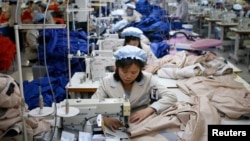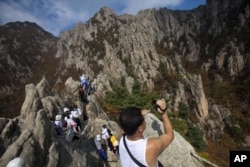South Korean workers have begun their pullout from the Kaesong Industrial Complex in North Korea following new sanctions imposed on Pyongyang for its recent nuclear and rocket tests.
On Wednesday Seoul announced it would suspend all activities at the industrial zone it operates jointly with North Korea to punish the Kim Jong Un government for its fourth nuclear test and latest long range missile launch.
Pyongyang reacted to Seoul’s announcement Thursday by declaring the industrial park a military control zone according the North’s official KCNA news agency. North Korea also said it would immediately deport all South Korean nationals, freeze the assets of companies operating there, and called the shut down a "declaration of war."
The North also said it was shutting down two crucial cross-border communications hotlines.
Out of work
The 124 small and medium South Korean manufacturing companies that operate in Kaesong already had begun pulling out staff, equipment and goods. The over 54,000 North Korean employees who work for these South Korean companies will now be out of work.
"We jokingly said Kaesong might be shut down, but I was surprised to see it really happening. In my personal opinion, I feel sorry for the North Koreans because they are way more worried than we are," said Kim Soo-hee, a South Korean nurse at the Kaesong Complex.
The closure will cut off the flow of about $100 million a year into North Korea. South Korean companies paid Kaesong employee wages directly to the Pyongyang government. Seoul suspects much of that money was not given to the workers but was used to advance the North’s nuclear weapons and long-range missile program.
U.N. Security Council resolutions have banned North Korea from developing nuclear weapons and ballistic missile technology and have imposed four rounds of increasingly stronger sanctions since 2006.
End of 'Sunshine Policy'
Terminating the Kaesong complex, the last remnant of South Korea’s Sunshine Policy of engagement with the North, ends virtually any hope, in the near future, of a peaceful settlement to the long-standing tensions on the Korean peninsula.
“If you look at our government’s way of handling North Korea, that apparently it is hoping for some kind of major collapse of the North Korea regime. But if that does not happen then there’ll be quite high tension (and) protracted confrontation between North and South Korea,” said Chung-in Moon, a professor of Political Science at Yonsei University in South Korea and advocate for inter-Korean engagement policies.
Over a decade ago, late South Korean President Kim Dae-jung initiated the Sunshine policy on the premise that through assistance and cooperative projects, North and South could build trust that would lead to peaceful co-existence and to some form of unification.
The Kaesong complex, located inside North Korea about 54 kilometers northwest of Seoul, was intended to promote inter-Korean understanding and give North Korean workers a taste of life in the south, including snack foods like Choco Pies and toiletries that were resold as luxury items in the North.
Over the years, support in the South for unqualified engagement faded as the North continued its defiant pursuit of nuclear weapons and continued to initiate provocations.
The other major joint project, the Kumgang Mountain tourist zone, was shut down in 2008 after a North Korean soldier shot a South Korean visitor. Other South Korean aid programs were halted and sanctions imposed against North Korea in 2010, after Seoul accused Pyongyang of sinking a South Korean warship and killing 46 sailors.
Except for Kaesong, both countries forbid their citizens from communicating with each other across the world's most fortified frontier.
South Korean President Park Geun-hye came to power in 2013, and like her predecessor President Lee Myung-bak, has taken a harder line in dealing with the North.
Last December during rare inter-Korean talks, Seoul refused to re-open the Kumgang tourist program in exchange for Pyongyang’s offer to support further reunions of separated families.
“I think there was no compromise on the South Korean side. Our government has been quite inflexible in dealing with North Korea,” said Professor Moon.
Compelling Pyongyang
In the wake of the latest missile launch and nuclear test, Seoul along with Washington and Tokyo have more fully committed to compel Pyongyang to comply with international demands to end its nuclear program.
The U.S. Senate voted unanimously Wednesday to adopting stronger sanctions that would target U.S. assets of individuals or companies that import North Korean goods, technology or training related to weapons of mass destruction, or are connected to human rights abuses.
Japan imposed unilateral sanctions Wednesday, including prohibiting North Korean ships from entering Japanese ports and a total entry ban on the entry of North Korean nationals into Japan.
Washington and Beijing are still reportedly at odds over imposing strong United Nations sanctions. China has said it does not want to trigger regional instability.
Analysts say that unless China’s goes along with proposed measures to cut off trade and aid to its ally, sanctions will have a very limited impact.
U.S., Japanese and South Korean defense forces agreed Wednesday to increase information-sharing and coordination of security efforts.
The United States and South Korea are also proceeding with formal talks to deploy the controversial THAAD missile defense system.
China and Russia have protested stationing THAAD on the Korean peninsula in part because the over 1,000-kilometer reach of the system radar can potentially be used to monitor military installations in their countries.


